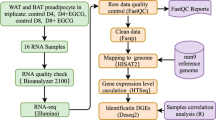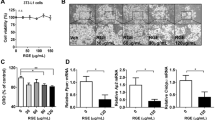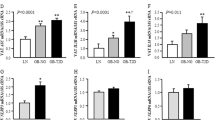Abstract
BACKGROUND:
North American (NA) ginseng (Panax quinquefolius) is a popular natural health product (NHP) that has been demonstrated to regulate immune function, inflammatory processes and response to stress and fatigue. Recent evidence suggests that various extracts of NA ginseng may have different bioactivities because of distinct profiles of ginsenosides and polysaccharides. To date, the bioactive role of ginseng on adipocytes remains relatively unexplored.
OBJECTIVE:
The goal of this work was to study the extract-specific bioactivity of NA ginseng on differentiated preadipocyte gene expression and adipocytokine secretion.
METHODS:
In vitro differentiated 3T3-L1 preadipocytes were treated with 25 and 50 μg ml−1 of either crude ethanol (EtOH) or aqueous (AQ) NA ginseng extracts, or polysaccharide and ginsenoside extracts isolated from the AQ extract. Global gene expression was studied with microarrays and the resulting data were analyzed with functional pathway analysis. Adipocytokine secretion was also measured in media.
RESULTS:
Pathway analysis indicated that the AQ extract, and in particular the polysaccharide extract, triggered a global inflammomodulatory response in differentiated preadipocytes. Specifically, the expression of Il-6 (interleukin 6), Ccl5 (chemokine (C–C motif) ligand 5), Nfκb (nuclear factor-kappaB) and Tnfα (tumor necrosis factor alpha) was increased. These effects were also reflected at the protein level through the increased secretion of IL-6 and CCL5. No effect was seen with the EtOH extract or ginsenoside extract. Using a specific toll-like receptor 4 (TLR4) inhibitor reduced the upregulation of inflammatory gene expression, indicating the relevance of this pathway for the signaling capacity of NA ginseng polysaccharides.
CONCLUSION:
This work emphasizes the distinct bioactivities of different ginseng extracts on differentiated preadipocyte signaling pathways, and highlights the importance of TLR4 for mediating the inflammomodulatory role of ginseng polysaccharides.
This is a preview of subscription content, access via your institution
Access options
Subscribe to this journal
Receive 12 print issues and online access
$259.00 per year
only $21.58 per issue
Buy this article
- Purchase on Springer Link
- Instant access to full article PDF
Prices may be subject to local taxes which are calculated during checkout





Similar content being viewed by others

References
Banz WJ, Iqbal MJ, Bollaert M, Chickris N, James B, Higginbotham DA et al. Ginseng modifies the diabetic phenotype and genes associated with diabetes in the male ZDF rat. Phytomedicine 2007; 14: 681–689.
Pannacci M, Lucini V, Colleoni F, Martucci C, Grosso S, Sacerdote P et al. Panax ginseng C.A. Mayer G115 modulates pro-inflammatory cytokine production in mice throughout the increase of macrophage toll-like receptor 4 expression during physical stress. Brain Behav Immun 2006; 20: 546–551.
Azike C, Charpentier P, Hou J, Pei H, King Lui E . The Yin and Yang actions of North American ginseng root in modulating the immune function of macrophages. Chin Med 2011; 6: 21.
Attele AS, Wu JA, Yuan C-S . Ginseng pharmacology: Multiple constituents and multiple actions. Biochem Pharmacol 1999; 58: 1685–1693.
Schepetkin IA, Quinn MT . Botanical polysaccharides: macrophage immunomodulation and therapeutic potential. Int Immunopharmacol 2006; 6: 317–333.
Shang W, Yang Y, Zhou L, Jiang B, Jin H, Chen M . Ginsenoside Rb1 stimulates glucose uptake through insulin-like signaling pathway in 3T3-L1 adipocytes. J Endocrinol 2008; 198: 561–569.
Karastergiou K, Mohamed-Ali V . The autocrine and paracrine roles of adipokines. Mol Cell Endocrinol 2010; 318: 69–78.
Deng Y, Scherer PE . Adipokines as novel biomarkers and regulators of the metabolic syndrome. Ann NY Acad Sci 2010; 1212: E1–E19.
McElhaney JE, Goel V, Toane B, Hooten J, Shan JJ . Efficacy of COLD-fX in the prevention of respiratory symptoms in community-dwelling adults: a randomized, double-blinded, placebo controlled trial. J Altern Complement Med 2006; 12: 153–157.
Pillitteri JL, Shiffman S, Rohay JM, Harkins AM, Burton SL, Wadden TA . Use of dietary supplements for weight loss in the United States: Results of a national survey. Obesity 2008; 16: 790–796.
Mutch DM, Rouault C, Keophiphath M, Lacasa D, Clement K . Using gene expression to predict the secretome of differentiating human preadipocytes. Int J Obes 2009; 33: 354–363.
Ouchi N, Parker JL, Lugus JJ, Walsh K . Adipokines in inflammation and metabolic disease. Nat Rev Immunol 2011; 11: 85–97.
Babish JG, Pacioretty LM, Bland JS, Minich DM, Hu J, Tripp ML . Antidiabetic screening of commercial botanical products in 3T3-L1 adipocytes and db/db mice. J Med Food 2010; 13: 535–547.
Yeo C-R, Lee S-M, Popovich DG . Ginseng (Panax quinquefolius) Reduces Cell Growth, Lipid Acquisition and Increases Adiponectin Expression in 3T3-L1 Cells. Evid Based Complement Alternat Med 2011; 2011: 1–9.
Wu Y, Lu X, Xiang F-L, Lui EMK, Feng Q . North American ginseng protects the heart from ischemia and reperfusion injury via upregulation of endothelial nitric oxide synthase. Pharmacol res 2011; 64: 195–202.
Prifti E, Zucker JD, Clement K, Henegar C . FunNet: an integrative tool for exploring transcriptional interactions. Bioinformatics 2008; 24: 2636–2638.
Subramanian A . From the cover: Gene set enrichment analysis: A knowledge-based approach for interpreting genome-wide expression profiles. Proc Natl Acad Sci 2005; 102: 15545–15550.
Tsukumo DML, Carvalho-Filho MA, Carvalheira JBC, Prada PO, Hirabara SM, Schenka AA et al. Loss-of-function mutation in Toll-like receptor 4 prevents diet-induced obesity and insulin resistance. Diabetes 2007; 56: 1986–1998.
Rot A, von Andrian UH . Chemokines in innate and adaptive host defense: basic chemokinese grammar for immune cells. Annu Rev Immunol 2004; 22: 891–928.
Choi Y-J, Yoon J-H, Cha S-W, Lee S-G . Ginsenoside Rh1 inhibits the invasion and migration of THP-1 acute monocytic leukemia cells via inactivation of the MAPK signaling pathway. Fitoterapia 2011; 82: 911–919.
Lee DC, Lau AS . Effects of panax ginseng on tumor necrosis factor-α-mediated inflammation: a mini-review. Molecules 2011; 16: 2802–2816.
Greenbaum D, Colangelo C, Williams K, Gerstein M . Comparing protein abundance and mRNA expression levels on a genomic scale. Genome Biol 2003; 4: 117.
Acknowledgements
This research was funded by the Ontario Ginseng Research and Innovation Consortium (OGIRC), the Ontario Ministry of Agriculture, Food and Rural Affairs (OMAFRA), the Natural Sciences and Engineering Research Council of Canada (NSERC) and the Canada Foundation for Innovation with matching funds from the Ontario Research Fund (CFI/ORF). Special thanks to Kaitlin Roke for her contributions to the BioPlex protein secretion analysis.
Author information
Authors and Affiliations
Corresponding author
Ethics declarations
Competing interests
The authors declare no conflict of interest.
Additional information
Supplementary Information accompanies the paper on International Journal of Obesity website
Rights and permissions
About this article
Cite this article
Wilson, S., Wong, M., Stryjecki, C. et al. Unraveling the adipocyte inflammomodulatory pathways activated by North American ginseng. Int J Obes 37, 350–356 (2013). https://doi.org/10.1038/ijo.2012.50
Received:
Revised:
Accepted:
Published:
Issue Date:
DOI: https://doi.org/10.1038/ijo.2012.50


